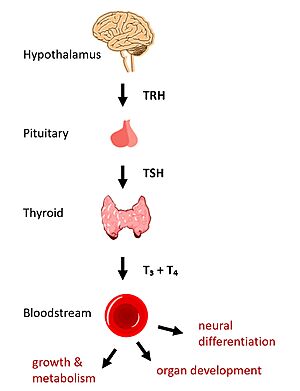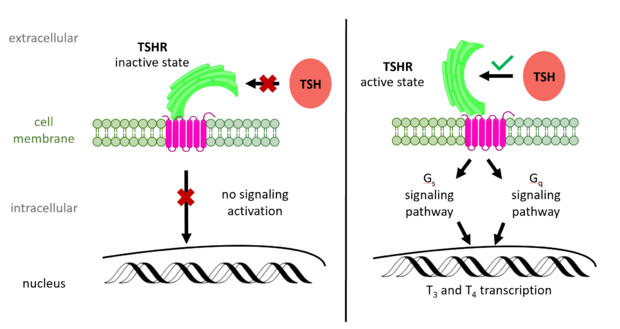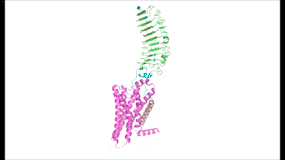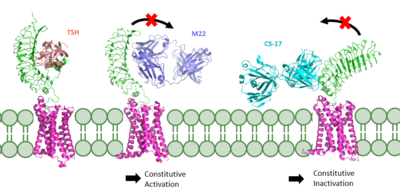Sandbox Reserved 1774
From Proteopedia
(Difference between revisions)
| Line 15: | Line 15: | ||
== Molecular Structure and Function of TSHR == | == Molecular Structure and Function of TSHR == | ||
=== Role of TSHR Domains === | === Role of TSHR Domains === | ||
| - | To understand how the structure of TSHR contributes to its function, it is helpful to become familiar with the three main domains of TSHR. First is the <scene name='95/952703/Tmd/14'>extracellular domain (ECD)</scene>, which is concave in shape. It is also called the <scene name='95/952703/Leucines_in_tmd/1'> | + | To understand how the structure of TSHR contributes to its function, it is helpful to become familiar with the three main domains of TSHR. First is the <scene name='95/952703/Tmd/14'>extracellular domain (ECD)</scene>, which is concave in shape. It is also called the <scene name='95/952703/Leucines_in_tmd/1'>leucine rich region (LRR)</scene> because it is made primarily of beta sheets which are rich in leucine <ref name="Kleinau">Kleinau G, Worth CL, Kreuchwig A, et al. Structural–Functional Features of the Thyrotropin Receptor: A Class A G-Protein-Coupled Receptor at Work. Frontiers in Endocrinology. 2017;8. Accessed April 2, 2023. [https://doi.org/10.3389/fendo.2017.00086 DOI: 10.3389/fendo.2017.00086]</ref>. The ECD contains <scene name='95/952703/Lysines_in_tmd/1'>lysine residues</scene> which play a key role in TSH binding. Second is the <scene name='95/952703/Tmd/15'>transmembrane domain (TMD) </scene>, which is composed of seven transmembrane alpha helices which are connected by extracellular loops (ECL). The TMD undergoes a conformation change upon ligand binding that activates the intracellular GPCR signal cascade <ref name="Duan" />. The third region of the TSHR is the <scene name='95/952703/Tmd/16'>hinge region</scene>, which plays a key role in the movement and stability of the TSHR. The details of the hinge mechanism are discussed in the proceeding section. |
[[Image:TSH Signaling.png|right|620 px|thumb|Figure 2: (Left) In the downright, inactive state, TSH cannot bind and no signaling activation occurs. (Right) In the upright, active state, binding of TSH leads to GPCR signaling activation and production of T3 and T4 hormones.]] | [[Image:TSH Signaling.png|right|620 px|thumb|Figure 2: (Left) In the downright, inactive state, TSH cannot bind and no signaling activation occurs. (Right) In the upright, active state, binding of TSH leads to GPCR signaling activation and production of T3 and T4 hormones.]] | ||
| Line 31: | Line 31: | ||
=== Stabilizing Interactions in the Hinge === | === Stabilizing Interactions in the Hinge === | ||
| - | + | TSHR hinge motion is influenced by molecular interactions in the hinge region. To understand these interactions, the hinge region can be subdivided into several parts: | |
| + | #The <scene name='95/952702/Hinge_helix_intro/3'>hinge helix</scene>, which lies at the intersection of the extracellular and transmembrane domains; | ||
| + | #<scene name='95/952702/Helix_1_intro/5'>helix 1</scene>, which sticks up and serves as a binding platform for the TSH ligand | ||
| + | #the <scene name='95/952702/Linker_intro/4'>linker</scene> region, which connects helix 1 with the p10 region | ||
| + | #The <scene name='95/952702/P10_intro/2'>p10</scene> region, a conserved 10-amino acid sequence which connects to transmembrane helix 7 and undergoes most of the deformation <ref name="Faust" /> <ref name="Duan">PMID:35940204</ref>. | ||
| - | + | Of the TSHR hinge subregions, the p10 peptide is noteworthy because it serves as an internal agonist of TSHR activation <ref name="Bruser" />. Specifically, an <scene name='95/952702/Ionic_interaction/3'>ionic interaction</scene> between K660 in TM helix 7 and E409 in the p10 region stabilizes TSHR in the active conformation. If this interaction is disrupted with an E409A mutation, diminished receptor activation and TSH potency is observed <ref name="Faust" />. Other mutations in the p10 are poorly tolerated in both TSHR and other glycoprotein hormone receptors <ref name="Faust" />. | |
| - | + | ||
| - | + | ||
| - | + | Beyond the p10 region, the active conformation of TSHR is also stabilized by a <scene name='95/952702/Hydrophobic_interaction/2'>hydrophobic interaction</scene> between Y279 in the hinge helix and I486 in ECL region 1 <ref name="Faust" />. If this interaction is disrupted with an I496F mutation, constitutive receptor activation and decreased sensitivity to the TSH ligand. This receptor overactivation is attributed to over-stabilization of the hydrophobic interaction by the bulkier phenylalanine <ref name="Faust" />. In this way, TSHR function is directly affected by stabilizing interactions in the hinge. | |
| - | + | ||
| - | + | ||
| - | + | Rather than stabilization, two disulfide bonds in the hinge region are responsible for constraining the movement of the hinge <ref name="Kleinau" />. The <scene name='95/952702/P10_hinge_disulfide/4'>first disulfide bridge</scene> connects the hinge helix to the linker region, and the <scene name='95/952702/Linker_hinge_disulfide/3'>second disulfide bridge</scene> connects the hinge helix to the p10 region <ref name="Duan" />. By directly linking parts of the hinge, the disulfide bonds serve to keep the ECD and TMD in close proximity while allowing the domains to move relative to one another <ref name="Kleinau" />. | |
== Ligand Binding == | == Ligand Binding == | ||
Revision as of 16:44, 15 April 2023
| This Sandbox is Reserved from February 27 through August 31, 2023 for use in the course CH462 Biochemistry II taught by R. Jeremy Johnson at the Butler University, Indianapolis, USA. This reservation includes Sandbox Reserved 1765 through Sandbox Reserved 1795. |
To get started:
More help: Help:Editing |
| |||||||||||




